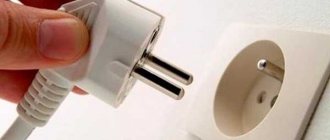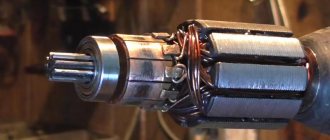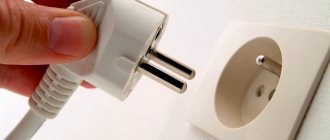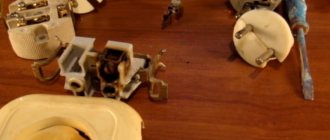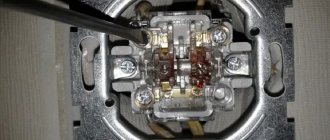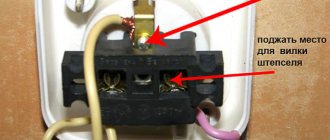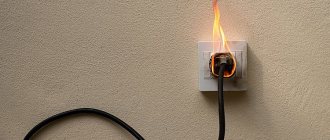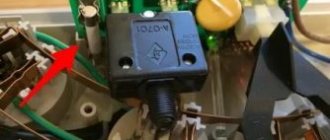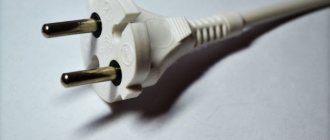The socket sparks because the plug does not fit
The most common reason that an outlet sparks is that the plug does not match the standards. Many people have had sockets since the construction of the house or the last renovation. And this is often 10 or even 20 years. At that time, these products were manufactured for electrodes with a diameter of 4 mm. Modern forks have a fork diameter of 4.8 mm. As a result of this discrepancy, it turns out that a thicker plug stretches the contacts in the socket. When you turn on a device that has 4 mm electrodes, the contact is insufficient, and therefore the socket sparks.
I would like to say that there are currently a lot of household appliances with a 4 mm plug. These include phone chargers, meat grinders, routers, and even TVs.
Loose screw terminal contact.
This is relevant mainly for sockets, the power to which is supplied by aluminum wires. Aluminum is a soft metal, and over time it can itself “leak” from under the contact point, so clamp connections using aluminum must sometimes be tightened. Why aluminum cable cannot be used in electrical wiring. If this is not done in time, the contact between the socket connector and the wire will deteriorate more and more, and sparking may occur. When you touch the fork, it will intensify. It is better not to let this situation happen - all screw connections must be serviced in a timely manner.
How to check voltage in sockets.
Socket sparks due to overload
A socket, like, in principle, any other household appliance, has certain characteristics and parameters. Each product is marked accordingly. For example, a 16 A and 250 Volt outlet can withstand a load of 3.5 kW.
- 6 Amps – 1.3 kW
- 10 Amps – 2.2 kW
- 32 Ampere – 7 kW
Exceeding the maximum permissible loads will lead to overheating of the socket contacts. As a result, they burn and resistance increases. Based on this, we can conclude that a large number of extension cords and overly powerful devices cannot be plugged into one outlet.
What to do to eliminate sparking
We saw that the reasons for the appearance of sparks are different. Therefore, what to do if the outlet sparks depends on the specific situation:
- If the parameters of the electrical accessories do not match, you need to bring them to a single form - replace the electrical sockets or buy European adapters for them. If you have old equipment in your home, it is better to change their plugs.
- If there is an overload, you can fix the problem in different ways. Firstly, you can replace the electrical accessories with more powerful ones. For example, instead of electrical sockets designed for 10 A, install 16 A. The second possible option is to install double sockets or a block of them. This is more reliable than using tees to turn on household appliances.
- If the reason why the socket sparks when you insert the plug is a worn-out plug connector, it can be repaired (unless it's a bad case). To do this, you must first turn off the power to the line, remove the socket, clean the contacts, and bend the contact plates using thin pliers.
- When loosening the screw terminals, you need to tighten the contacts, having first disconnected the power supply. If the wiring is copper, you need to do this procedure approximately once every 5-10 years, if the wires are aluminum - once every two years.
- If the electrical accessories are of low quality, it is better to replace them with more reliable ones. Low-grade products can be distinguished by the lack of packaging, incomplete packaging, and low quality plastic housing.
Important! If you do not have experience in handling electrical accessories, it is better to call a specialist at your home. He will determine why the socket is sparking when you turn on the plug, and quickly fix the problem.
Low quality
As I wrote earlier in my article “What You Shouldn’t Save on When Repairing,” electricians do not tolerate purchasing low-quality products. If you are not yet familiar with this material, you can read it at this link.
You can try to save your money on laminate, paint or drywall, but never on electrical fittings or wiring. Such savings will not only lead to possible breakdowns of other household appliances, but will also create a fire hazard in the home. A high-quality product will easily withstand the load indicated on it. Cheap options from unknown manufacturers can even be burned by a vacuum cleaner. It is best to purchase goods from trusted suppliers. I would recommend checking out the range and prices on Yandex Market.
Electrical and mechanical overload
The majority of commercially available sockets and plugs are designed for a current of 16 A. Copper and aluminum cables with a cross-section of 2.5 mm2, used to connect to a household network, can easily withstand it. Soviet-style plugs were designed for a current of 6 A, which limits their use. In addition, they do not have a grounding contact; they cannot be used to connect consumers with a protective conductor. Exceeding the rated currents leads to sockets sparking, overheating, and failure. Of course, it is difficult to imagine that it is possible to connect a single load with a power exceeding 3.5 kW. But there are other ways that lead to a similar result. This is the use of extension cords and splitters. Extension cords also have their own rated currents. This applies to sockets installed in them, plugs and connecting wires. If several heating devices are connected to the extension cord and the total load current exceeds the maximum permissible, not only the socket sparks and heats up, but also the plug, as well as the connecting wires. This can damage the outlet and start a fire.
Distributors (for example, tees), in addition to the fact that they also have a permissible current of the contact system, which should not be exceeded, also exert a mechanical load on the socket. Several plugs with wires and the weight of the tee itself pull it down, slightly bending the pins of the plug in the contact system, ultimately worsening the contact. Therefore, if you have many electrical appliances that need to be connected to the network in one room, it is better to install additional sockets in places where they will be more convenient to use. The use of extensions and tees should be avoided as much as possible. Sometimes the problem is solved by installing a double socket, if the total current of household appliances connected to it does not exceed 16 A.
The socket is sparking - how to fix it?
Once you have determined why the outlet is sparking, you can begin to fix the problem. Well, if everything is clear with the last point about purchasing only high-quality products, then we will now consider solving the remaining problems.
- To solve the problem of non-compliant sockets and plugs, you will have to spend a little money. You need to replace the old models with Euro standard models. It’s not that much money, but you’ll forget about the sparking of the socket for a long time.
- In order not to overload one outlet, I recommend installing a block of sockets. It’s better to install 2 or 3 than to connect a bunch of extension cords or surge protectors. It would also be advisable to replace the weak version with a more powerful one. So if you have a 10 A socket installed, and there is a significant load on it, then it is better to install it at 16 A or 32 A.
Did you know that you won't miss any of our content if you subscribe? Subscribing is easy: just enter your email in the form below this article and click on the “Subscribe to newsletter” button. And you will always be aware of our publications!
I hope my article today was clear and useful. Now you know why the socket sparks when you insert a plug, and how to fix it. Write in the comments if you have encountered such a problem?
How to fix the problem
Worn wiring can cause sparks to form in the socket.
If the sockets spark, you need to call an electrician or try to fix the problem yourself. First of all, turn off the power to the panel and warn the apartment residents about the repair. To inspect the contact part, you will need to remove the front panel. Procedure:
- Check the condition of the wires; oxidation on the copper must be cleaned with sandpaper.
- Tighten the screw terminals with a screwdriver and bend the contact plates.
- Inspect the wiring; if there are exposed areas, cover them with insulating tape.
- Secure the structure with the set screws located on the sides.
You can check the quality of the repaired structure by inserting a plug. A tight crimp of the pins indicates that the main problems have been eliminated. After the electricity supply is restored, the point is checked by turning on a medium-power appliance, such as an iron. If the result is satisfactory, it is recommended to periodically monitor the condition of the plug connector.
If the contacts and plastic are blackened and charred, it is better to replace the socket. If the standards do not meet, you will have to buy a modern electrical installation product of a suitable type. It will ensure normal use of household appliance plugs.
It is impossible to increase the power of the outlet, so to connect electric boilers and furnaces, install a structure with a rated current of at least 16 A. If the power of one point is not enough, several should be installed. The socket block is safer than the tee.
First reason. The plug is faulty.
The first reason for heating the outlet may not be a malfunction of the outlet itself, but... a malfunction of the plug. The fact is that if the contact inside the plug deteriorates and it begins to heat up, the heat will be transferred to the body of the socket and its contacts. Visually, it may seem that it is the outlet that is heating up, although the reason is the plug.
The solution here is simple! Insert the plug into another outlet (preferably in another room) that has not had any problems until now. Turn on the appliance that is powered by this plug.
Wait 5-10 minutes. Remove the plug from the socket and touch the contacts of the plug. If they are hot, then the problem is in the plug; if they are cold, it is in the socket.
In addition, power some powerful device from the first (suspicious) outlet. For example a heater. Wait 5 minutes and feel the plug contacts. Heating will indicate a faulty socket, because... The default plug is OK.
The main reasons for sparking sockets
There are not so many reasons why an outlet sparks, including:
1. Most often, it is a weakened connection that causes sparking . In most modern sockets, screw terminals are used to connect the wires of the input electrical cable, which, according to the regulations, must be periodically tightened, otherwise the exposed wire will no longer fit tightly to the contacts and sparking will occur.
2. If the operating mode of the outlet is violated, when currents pass through it for which it is not designed, the outlet becomes very hot . In this case, the connection point of the conductors may burn, oxidize, etc. and the reliability of contact decreases. For example, this happens when several powerful consumers are simultaneously connected to an outlet through a tee.
Poor-quality connectors in sockets can become loose over time and become loose around the pins of the electrical plug. In addition, low-quality alloys may have been used in their manufacture, which weaken or oxidize over time.
3. Poor quality or non-standard electrical plug. Often, the pins of an electrical plug are smaller in size than they should be or they are made of low-quality, unsuitable alloy, which over time or immediately leads to sparking.
But what does such sparking threaten us with, is it dangerous at all or is it just an additional “effect” of the operation of an electrical appliance, let’s figure it out together.
How to extend the wire?
Sometimes this has to be done, especially if there is no collapsible plug at hand, but there is a broken electrical appliance from which you can cut off the required part along with a piece of wire. By the way, this will allow you to slightly lengthen the cord of the device you are repairing.
Operating procedure:
- Cut the cord and plug from the broken device - preferably to the maximum possible length. If extensions are not intended, it is enough to leave a piece of 15 cm.
- Cut the sheath of the cords lengthwise by 10 cm without damaging the insulation.
- Pull the wires out without cutting the sheath.
- You will most likely see three wires - red (brown), blue (cyan) and green: phase, neutral and ground.
- Adjust the length of the conductors - the places of twists should be 2-2.5 cm apart from each other.
- Remove the insulation from each wire by 1.5 cm. However, if one wire has a green wire and the other does not, the insulation cannot be removed from it.
- Connect single-color wires with twists - three turns are enough.
- Solder the wires.
- Clean the solder joints, removing protrusions and sharp edges.
- Tuck the wires into the sheath.
- For reliability, the wire can be insulated, but this is not necessary if the twists do not touch.
If the socket cracks during operation
If a cracking sound is heard when the plug is in the socket, then this is already a sign of poor contact in some part of the electrical circuit. Often, over time, the surface of the plug or the socket itself heats up, or even all at once.
What kind of lighting do you prefer?
Built-in Chandelier
Causes of crackling noise in a working outlet
In fact, a working socket makes noise for the same reason as when inserting a plug - the contacts do not touch closely, and in some places they do not reach each other. The consequences are standard: their surface oxidizes, resistance to electric current increases and the metals begin to heat up.
In the same way, a socket cracks if the bolted connections are loosened - the wire inside the contact begins to move and protrusions form, between which sparks appear. The socket begins to make noise, and if the contact is very bad, it can heat up and melt.
Expert opinion
Viktor Pavlovich Strebizh, lighting and electrical expert
Any questions ask me, I will help!
Check all the switches, listen with your ear to see if there is a router or something that gives out Wi-Fi, also listen. The power supply of the radiotelephone can sometimes start to sing. If there is something you don’t understand, write to me!
